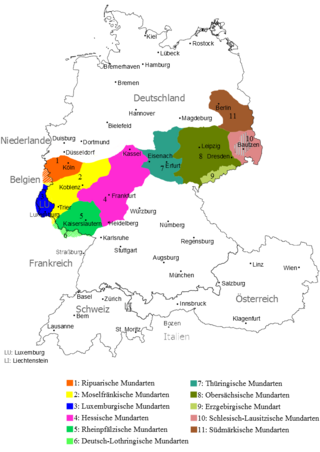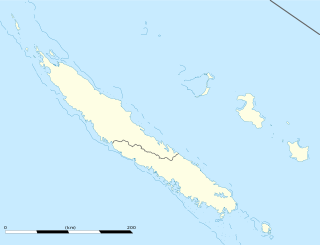Related Research Articles
Linguistics is the scientific study of human language. Someone who engages in this study is called a linguist. See also the Outline of linguistics, the List of phonetics topics, the List of linguists, and the List of cognitive science topics. Articles related to linguistics include:

Lingua Franca Nova, abbreviated as LFN and known colloquially as Elefen, is an auxiliary constructed language originally created by C. George Boeree of Shippensburg University, Pennsylvania, and further developed by many of its users. Its vocabulary is based primarily on the Romance languages, namely French, Italian, Portuguese, Spanish, and Catalan. Lingua Franca Nova has phonemic spelling based on 22 letters from the Latin script; a Cyrillic alphabet was co-official until 2021.
This article outlines the grammar of the Dutch language, which shares strong similarities with German grammar and also, to a lesser degree, with English grammar.
Brithenig, or also known as Comroig, is an invented language, or constructed language ("conlang"). It was created as a hobby in 1996 by Andrew Smith from New Zealand, who also invented the alternate history of Ill Bethisad to "explain" it. Officially according to the Ill Bethisad Wiki, Brithenig is classified as a Britanno-Romance language, along with other Romance languages that displaced Celtic.

Bermudian English is a regional dialect of English found in Bermuda, a British overseas territory in the North Atlantic. Standard English is used in professional settings and in writing, while vernacular Bermudian English is spoken on more casual occasions. The Bermudian dialect began to develop following settlement in the early 17th century and retains traits of Elizabethan English.
Lithuanian grammar retains many archaic features from Proto-Balto-Slavic that have been lost in other Balto-Slavic languages.
Tokelauan is a Polynesian language spoken in Tokelau and historically by the small population of Swains Island in American Samoa. It is closely related to Tuvaluan and is related to Samoan and other Polynesian languages. Tokelauan has a co-official status with English in Tokelau. There are approximately 4,260 speakers of Tokelauan, of whom 2,100 live in New Zealand, 1,400 in Tokelau, and 17 in Swains Island. "Tokelau" means "north-northeast".
Cape Verdean Creole is a Portuguese-based creole language spoken on the islands of Cape Verde. It is the native creole language of virtually all Cape Verdeans and is used as a second language by the Cape Verdean diaspora.
L-vocalization, in linguistics, is a process by which a lateral approximant sound such as, or, perhaps more often, velarized, is replaced by a vowel or a semivowel.

Portuguese orthography is based on the Latin alphabet and makes use of the acute accent, the circumflex accent, the grave accent, the tilde, and the cedilla to denote stress, vowel height, nasalization, and other sound changes. The diaeresis was abolished by the last Orthography Agreement. Accented letters and digraphs are not counted as separate characters for collation purposes.

English is a West Germanic language in the Indo-European language family, whose speakers, called Anglophones, originated in early medieval England. The namesake of the language is the Angles, one of the ancient Germanic peoples that migrated to the island of Great Britain. Modern English is both the most spoken language in the world and the third-most spoken native language, after Mandarin Chinese and Spanish. It is also the most widely learned second language in the world, with more second-language speakers than native speakers.

Erzgebirgisch is a (East) Central German dialect, spoken mainly in the central Ore Mountains in Saxony. It has received relatively little academic attention. Due to the high mobility of the population and the resulting contact with Upper Saxon, the high emigration rate and its low mutual intelligibility with other dialects, the number of speakers is decreasing.

Tayo, also known as "patois de Saint-Louis", is a French-based Creole spoken in New Caledonia. It is spoken by about 3000 people in the village of Saint-Louis, about 15 km (9.3 mi) from the New Caledonian capital Nouméa. The language developed out of the contact of speakers of many different Kanak languages in the mission, and the use of French for official purposes and as the language of prestige. The language contains structural elements primarily from Melanesian languages and lexical elements mainly from French.

Maliseet-Passamaquoddy is an endangered Algonquian language spoken by the Maliseet and Passamaquoddy peoples along both sides of the border between Maine in the United States and New Brunswick, Canada. The language consists of two major dialects: Maliseet, which is mainly spoken in the Saint John River Valley in New Brunswick; and Passamaquoddy, spoken mostly in the St. Croix River Valley of eastern Maine. However, the two dialects differ only slightly, mainly in their phonology. The indigenous people widely spoke Maliseet-Passamaquoddy in these areas until around the post-World War II era when changes in the education system and increased marriage outside of the speech community caused a large decrease in the number of children who learned or regularly used the language. As a result, in both Canada and the U.S. today, there are only 600 speakers of both dialects, and most speakers are older adults. Although the majority of younger people cannot speak the language, there is growing interest in teaching the language in community classes and in some schools.
Hidatsa is an endangered Siouan language that is related to the Crow language. It is spoken by the Hidatsa tribe, primarily in North Dakota and South Dakota.
Raga is the language of northern Pentecost Island in Vanuatu. Like all Vanuatu languages, Raga belongs to the Oceanic subgroup of the Austronesian languages family. In old sources the language is sometimes referred to by the names of villages in which it is spoken, such as Bwatvenua (Qatvenua), Lamalanga, Vunmarama and Loltong.
Talise is a Southeast Solomonic language native to Guadalcanal with a speaker population of roughly 13,000. While some consider Talise to be its own language, others use it as a blanket term to group the closely related dialects of Poleo, Koo, Malagheti, Moli, and Tolo. It is a branch of the Proto-Guadalcanal family, which forms part of the Southeast Solomons language group.
This page describes the grammar of Maithili language, which has a complex verbal system, nominal declension with a few inflections, and extensive use of honoroficity. It is an Indo-Aryan language native to the Maithili people and is spoken in the Indian state of Bihar with some speakers in Jharkhand and nearby states.The language has a large number of speakers in Nepal too, which is second in number of speakers after Bihar.
Turkmen grammar is the grammar of the Turkmen language, whose dialectal variants are spoken in Turkmenistan, Iran, Afghanistan, Russia, China, Uzbekistan, Tajikistan and others. Turkmen grammar, as described in this article, is the grammar of standard Turkmen as spoken and written by Turkmen people in Turkmenistan.
Belter Creole, also simply known as Belter, is a constructed language developed by the linguist and polyglot Nick Farmer for The Expanse television series. In the universe, it was spoken by Belters, inhabitants of the asteroid belt and the moons of outer planets of the Solar System.
References
- ↑ Holm, John A. (1989). "Cayman Islands". Pidgins and Creoles. Vol. 2, Reference Survey. Cambridge University Press. pp. 479–480. ISBN 978-0-521-35940-5.
- ↑ "How to speak Caymanian | Local Culture in the Cayman Islands". Visitcaymanislands.com. Retrieved 2022-12-24.
- Washabaugh, William (1983). "The Off-shore Island Creoles: Providencia, San Andres and the Caymans". In Holm, John A. (ed.). Central American English. John Benjamins Publishing. pp. 174–179. ISBN 3-87276-295-8.